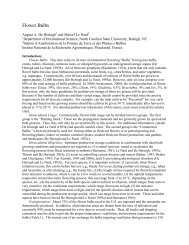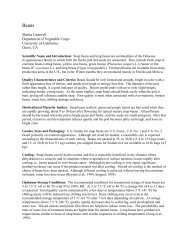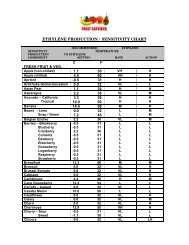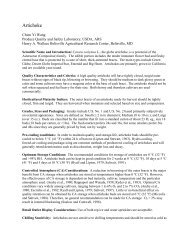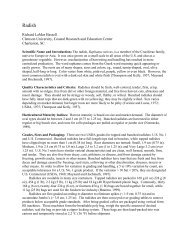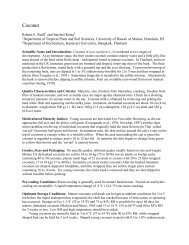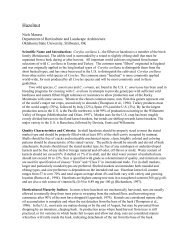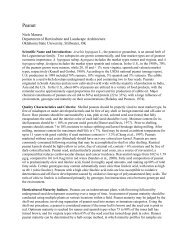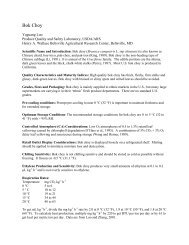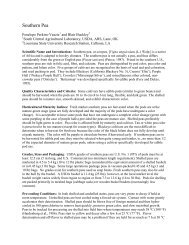Horseradish
Horseradish
Horseradish
Create successful ePaper yourself
Turn your PDF publications into a flip-book with our unique Google optimized e-Paper software.
<strong>Horseradish</strong><br />
Dr. Franciszek Adamicki<br />
Department of Vegetable Storage, Research Institute of Vegetable Crops<br />
Skiemiewice, Poland<br />
Scientific Name and Introduction: <strong>Horseradish</strong> Armoracia rusticana Gaertn.,Mey.,Scherb. is a<br />
perennial of the Cruciferae family. The plant is native to southeastern Europe, where the roots and leaves<br />
are used for food, condiments and medicinal purposes. <strong>Horseradish</strong> is grown for its enlarged taproot,<br />
which is used as an appetizing condiment for meats and fish. The characteristic pungent aroma and taste<br />
comes from sulfur compounds. <strong>Horseradish</strong> is grown worldwide, especially in Europe, the U.S. (mainly<br />
southwestern Illinois), Russia and other countries.<br />
Quality Characteristics and Criteria: Several criteria are used for quality evaluation of horseradish<br />
such as uniformity of shape and size, firmness, smoothness, freedom from hollow heart, internal color of<br />
the roots, other defects and decay. Long and uniform roots with white color of fleshy rhizomes and<br />
pungent flavor are the most important quality criteria.<br />
Horticultural Maturity Indices: <strong>Horseradish</strong> is ready to harvest after the leaves have been killed by<br />
frost. Sometimes it is harvested at an early stage of development and the roots used for processing.<br />
<strong>Horseradish</strong> that is harvested when roots are actively growing does not store as well as roots that are<br />
conditioned by cold before harvest.<br />
Grades, Sizes and Packaging: <strong>Horseradish</strong> roots Grade I should be at least 25 cm (10 in) long and 2.5<br />
cm (1 in) in diameter measured one-third of the distance from the top. Grade II are 15 cm (6 in) long and<br />
1.5 cm (0.6 in) in diameter. Smaller roots may be acceptable for processing. <strong>Horseradish</strong> for fresh<br />
harvest is commonly packed in 20 to 25 kg (44 to 55 lb) sacks or in small retail packages about 1 kg (2.2<br />
lb). Roots intended for storage are packed in 15 kg (33 lb) polyethylene lined crates or large containers<br />
capacity 300 to 500 kg (660 to 1100 lb).<br />
Pre-cooling conditions: <strong>Horseradish</strong> roots are very sensitive to wilting. Immediately after harvest, roots<br />
should be pre-cooled to 4 to 5 °C (39 to 41 °F) using forced-air cooling or placed at 0 °C (32 °F) with 90<br />
to 98% RH.<br />
Optimum Storage Conditions: Roots can be stored for 8 to 12 mo at 0 °C (32 °F) with 98 to 100% RH<br />
(Adamicki et al. 1999). Pungency is rapidly lost at higher temperatures, and roots dry out at lower RH.<br />
Perforated polyethylene bags and lined crates or bins can maintain a high RH during storage. Roots can<br />
also be stored at -1 to -2 °C (28.4 to 30.2 °F). Freshly harvested and washed roots can be stored for<br />
several mo in polyethylene bags or lined polyethylene crates. In areas with mild Winters, horseradish<br />
may be left in the ground and harvested in early Spring. <strong>Horseradish</strong> can also be stored over Winter in<br />
cool cellars or in outdoor pits (clamps) or trenches.<br />
Controlled Atmosphere (CA) Considerations: There is no or only a slight benefit from CA. High<br />
levels of CO 2 increase respiration, but do not cause greater loss of weight, dry matter, or sugar content<br />
during storage. An increase in sucrose occurs as CO 2 increases up to 7.5% (Weichmann 1980).<br />
Retail Outlet Display Considerations: Washed horseradish roots packed in polyethylene bags can be<br />
placed on refrigerated shelves for several days at temperatures < 10 °C (50 °F).
Chilling Sensitivity: <strong>Horseradish</strong> roots are not chilling sensitive and can survive -7 to -8 °C (17.6 to 19.4<br />
°F) (Bohling and Hansen, 1980).<br />
Ethylene Production and Sensitivity: <strong>Horseradish</strong> roots produce a very low amount of ethylene at < 1<br />
µL kg -1 h -1 and are not particularly sensitive to ethylene exposure.<br />
Respiration Rates:<br />
Temperature mg CO 2 kg -1 h -1<br />
0 °C 8<br />
5 °C 14<br />
10 °C 25<br />
15 °C 32<br />
20 °C 40<br />
To get mL kg -1 h -1 , divide the mg kg -1 h -1 rate by 2.0 at 0 °C (32 °F), 1.9 at 10 °C (50 °F), and 1.8 at 20 °C<br />
(68 °F). To calculate heat production, multiply mg kg -1 h -1 by 220 to get BTU per ton per day or by 61 to<br />
get kcal per metric ton per day. Data are from Ryall and Lipton, 1983.<br />
Physiological Disorders: There are no particular physiological disorders of horseradish root.<br />
Postharvest Pathology: The soil borne fungus, Verticilium dahliae Kleb., infects the vascular tissue of<br />
the horseradish plant, resulting in discoloration (Eastburn and Weizierl, 1995). The discoloration often<br />
appears as black specks in cross-section or as streaks along the root when the root is cut length-wise. It is<br />
the major reason for loss in market quality of horseradish roots.<br />
Quarantine Issues: None.<br />
Suitability as Fresh-cut-Product: No current potential.<br />
References:<br />
Adamicki, F., W. Macias and E. Badełek. 1999. Effect of temperature on the quality and storage ability of<br />
two cultivars of horseradish. (unpublished).<br />
Bohling, H. and H. Hansen. 1980. Influence of controlled atmosphere on the respiration activity of<br />
achlorophyllous vegetable kinds. Acta Hort. 116:165-170.<br />
Dobrzański, A., Pałczyński and J. Adamicki, F. 1994. The influence and soil applied herbicides on weed<br />
control, yield and storage-life of horseradish ( Cochlearia armoracia L.). Biul. Warzywniczy. 42:53-<br />
63.<br />
Eastburn, D. and R. Weizierl. 1995. <strong>Horseradish</strong>. A quide to major insect and disease problems.Univ. of<br />
Illinois, Coop. Ext. Ser. (leaflet).<br />
Hardenburg, R.E., A.E. Watada and C.Y. Wang. 1986. The commercial storage of fruits, vegetables, and<br />
florist and nursery stocks. USDA Handbook No. 66.<br />
Ryall, A.L. and W.J. Lipton. 1983. Handling, transportation and storage of fruits and vegetables. Vol. 1,<br />
2 nd ed., AVI Pub. Co., Westport CT.<br />
Schirmer, H. and B. Tauscher. 1999. Langzeitlagerung von Meerretich bei unterschiedlichen<br />
Temperaturen. Gemüse 7:449-450.<br />
Weichmann, J. 1980. CA storage of horseradish (Armoracia rusticana Ph.Gärtn., B.May. et Scherb.).<br />
Acta Hort. 116:171-178.



